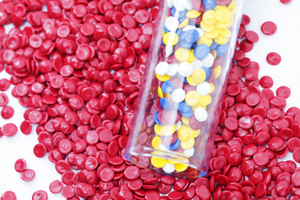The creation of one of the most popular plastics – polyethylene, was a matter of chance. It was invented over 100 years ago by a German researcher, Hans von Pechmann. In March 1933, two British chemists, Reginald Gibson and Eric Fawcett from Imperial Chemical Industries became interested in this material. The scientists started the mass production of this raw material, which soon revolutionised reality. What is polyethylene (PE)? What should you know about the properties and uses of polyethylene? Let’s get some answers!

What is PE? Definition and types
Today, the abbreviation “PE” can be found on many types of packaging, films and everyday objects. What does PE mean? It stands for polyethylene, a thermoplastic material in the form of synthetic polymers with high particle density. The product in the form of PE is created through ethylene polymerization, a process in which small particles, called monomers, combine.
Which elements make polyethylene? The structure of this plastic is quite simple – it consists of carbon and hydrogen. In the market of PE materials, you can find the following types of polyethylene:
- LDPE (low density polyethylene): low-pressure, soft PE with low particle density,
- HDPE (high density polyethylene): low-pressure, hard and dense polyethylene,
- PEX: durable cross-linked polyethylene,
- LLDPE: (linear low density) a soft plastic with low particle density,
- ULDPE (ultra low density): a thermoplastic with extremely low density,
- PE-RT (with a fabric-like structure, resistant to high temperatures (RT stands for Raised Temperature).
Scientists around the world are constantly improving polyethylene, giving it new properties. Many years of research and laboratory tests have resulted in, among others, a PE material called UHMWPE. It is one of the most durable polymers known today that is resistant to mechanical damage, microbial penetration and moisture.
The physico-chemical properties of polyethylene
What are the characteristics of polyethylene (PE)? The physico-chemical properties of this plastic deserve recognition because it is a material that:
- is thermoplastic and easy to process,
- is flexible,
- is resistant to low temperatures, tensile stress and abrasion,
- has low thermal conductivity,
- is dielectric (physical properties of polyethylene, associated with conduction of electricity are different for each PE polymer type).
What other valuable properties does polyethylene have? Its density ranges from 0.92 g/cm³ to 0.96 g/cm³. Depending on the density of the particles, PE plastics can be transparent, semi-transparent or white. Polyethylene – a combustible material, which melts quickly when exposed to high temperatures.
Polyethylene – chemical properties
The chemical properties of polyethylene are also noteworthy. It is a non-toxic material that does not produce harmful substances or unpleasant odours and does not let water, gas or pathogenic microorganisms pass through it. The polyethylene material is also resistant to acids and bases.

Polyethylene: uses
Plastics can be produced at a low cost, so it is not surprising that the range of PE applications is very diverse. Today, polyethylene is used for the production of items, packaging and housing for various devices that we use every day in our homes and under industrial conditions.
What are the uses of high density polyethylene? It is used, among others, for the production of:
- pipes and valves for water, sewage, ventilation and heating systems,
- containers for liquids, chemicals, fuels, household waste,
- bottles for beverages and cosmetics,
- slide strips,
- chemical-resistant flooring,
- fibre optic cable sheaths,
- automotive parts, power tools,
- toys,
- household appliances and accessories (high-density polyethylene is used for the production of cutting boards, handles, drawer runners, etc.).
Polyethylene – a plastic with great potential
Due to the extraordinary properties of polyethylene, such as resistance to damage, corrosion and water, new uses are constantly found for this raw material. It works well in the construction industry as well as in the pharmaceutical, chemical, food and cosmetic industries. The market of plastics was also conquered by soft polyethylene plastic, which is used for the production of packaging, plastic bags, stretch films and advertising bags. Read also about polypropylene.
- https://www.plastech.pl/plastechopedia/PE-24
- http://www.tworzywa.pwr.wroc.pl/pl/dydaktyka/polietylen
- https://plastipol.pl/polietylen-pe-wlasciwosci-zastosowanie/
- https://www.britannica.com/science/polyethylene
- https://www.xometry.com/resources/materials/polyethylene/